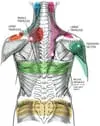Myofascial Pain
MYOFASCIAL PAIN SYNDROME
Myofascial pain syndrome is thought to be a form of muscle pain. It may result from a single trauma to a muscle or from repetitive minor trauma over time. There is no laboratory, radiographic or other diagnostic tests to prove the diagnosis for myofascial pain syndrome, so it is considered a “subjective” diagnosis. Many patients with myofascial pain develop “trigger or tender points”, which may be felt as "knots" of tissue under the skin. cHIROPRACTORS will help to determine whether painful areas are indications of myofascial pain syndrome being present. When trigger points are present and active, they can lead to discomfort in nearby muscles. Pain can be local and site specific, as well as radiating.
CAUSES
The painful trigger points develop in susceptible muscle tissues that are overworked for long periods of time. These muscles then develop focal areas or points of increased contraction [Figure 1]. These focal areas are not able to get their proper blood flow because the contracted muscle fibers are closing down the small blood vessels or capillaries that supply individual fibers with the necessary nutrients and oxygen. Furthermore, because the blood flow is insufficient, the muscle fibers are unable to get rid of toxic waste products (e.g. lactic acid) that build up during normal resting metabolic states. What ensues is a chronic cycle of pain in the affected tissues that is difficult to break out.
TRIGGER POINT
A Trigger Point is an exquisitely tender area in a muscle or ot
her soft tissue that is associated with a hypersensitive taut band and

Trigger Points can cause a wide variety of pains, sometimes distant to their own location. Trigger points are not only painful; there is also a tendency for muscle strains, tears or other injuries to occur at these points.
The pain of Trigger Points can be extreme. Chiropractors have even compared the pain of Trigger Points to the pain of kidney stones, angina pectoris or shingles.
Over 50% of visits to primary care practitioners are due to complaints of pain by the patient. Almost 90% of these painful complaints are due to trigger points.
Trigger Points are typically associated with a wide variety of myofascial dysfunctions, including chronic pain, weakness, limited range of motion and autonomic phenomena. Individuals with trigger points in numerous areas and who are experiencing various perpetuating factors may also be suffering from Widespread Myofascial Pain Syndrome or Fibromyaglia.
DIFFERENCE BETWEEN MYOFASCIAL PAIN AND FIBROMYALGIA
These conditions are different. Fibromyalgia is considered part systemic disease and part syndrome. Fibromyalgia has more clearly defined criteria for diagnosis, including generalized pain for more than 3 months, sleep disturbance, and a minimum number of specific tender points. Fibromyalgia may also be associated with irritable bowel syndrome, chronic fatigue syndrome, mitral valve prolapse as well as a possible family association. Myofascial pain syndrome and fibromyalgia are similar in that there is no laboratory or radiographic tests to prove that a patient has either one, and the diagnosis is made when other diseases have been ruled out.
SYMPTOMS
Symptoms usually involve pain in the muscle itself or in the muscle near a painful joint. Over time, this pain may spread to involve other muscles and tissues. This is typically described as “referred pain” because when pressure is applied to the painful trigger point, pain radiates to other parts of the body (usually, but not always, nearby to the trigger point) [Figure 2]. Stress, poor sleep and deconditioning have a significant effect on worsening the symptoms.
TREATMENT
Treatment of Myofascial trigger points involves decreasing the inflammation around the affected structures. Chiropractors often use Low Volt current, Ultrasound, to help reduce inflammation and restore normal biomechanics of the area. Manipulation is used to move the joint structures back into alignment. Stretching the affected musculature helps improve blood flow to the musculature, this enables normal nutrient delivery to the area, and allows for removal of lactic acid. Massage Therapy is also widely successful in the treatment of this condition. Massage Therapists use deep, trigger point work, helping to break up adhesions in the musculature, and restore flexibility of the area. Patients are encouraged to do aerobic exercise, and also to limit movements that cause deep, sustained contractions of the musculature.